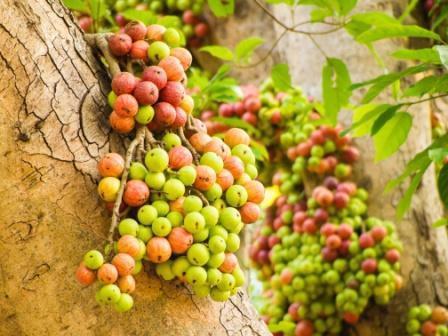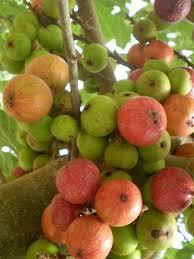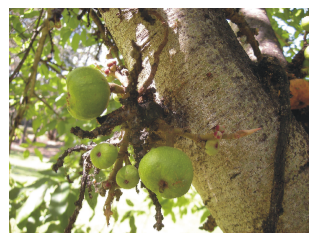Udumbara
Contents
- Introduction
- Description of the tree
- Puranic Reference
- Ayurvedic uses
- Significance
Introduction
Udumbara is the Sanskrit name for the fig tree. The other Sanskrit names are Apushpaphalasambandha, Haritaksha, and Hemadugda. The scientific name is Ficus racemosa. Udumbara is known as the Blue Lotus (Nila Kamal) in Buddhism. The plant belongs to the family of Moraceae. The English names of the plant are Cluster Fig Tree, Indian Fig Tree, or Goolar Tree. The vernacular names are in Hindi it is known as (Gulara), Kannada (Atti), Assamese (Jagna Dimaru), Telugu (Medi Pandu), Tamil (Malaiyin munivan), Malayalam (Atti), Bengali (Jagnadumur), Marathi (Audumbar) Gujarati (Umbro) and Oriya (Dumburi). The other synonyms are Yajniya, Yajnanga, Yajnayoga, Yajnyasara etc.
Description of the tree
Udumbara refers to both the tree and the flower/fruit. Udumbara is a medium to large deciduous spreading tree. The tree grows upto a height of 10-16 mts. Leaves are dark green measuring 7.5 – 10 cm long and ovate. The leaves wither in December and new leaves are seen by end of January- April. The tree is found all over India mainly near water streams. The tree is native to Australia, Malaysia, South East Asia and Indian Sub Continent. The tree grows well in well drained medium to heavy soil. Water logging and clay soil are not suitable for the cultivation of Udumbara plant. The tree also grows in hilltop areas too.
The flowers of the Udumbara tree are encased within the fruit. The flowers are not distinctly visible unlike other flowers.
The tree produces edible fruits which are pear shaped. They grow in clusters from the main branches or trunks. The fruit is green when raw, changes to orange or dullish red or dark crimson on ripening. The seeds within the fruit are grain like, tiny and innumerable. The fig is a staple food of the Indian Macaque, besides serving as a food plant for the caterpillars of the butterfly species- the two brand crow.
Bark of the Udumbara tree is reddish grey or greyish green, soft on surface, uneven and often cracked. The tree does not have aerial roots. Roots are irregular in shape, long, brownish in colour and taste bitter.

Propagation of the Udumbara plant is through the birds dropping the seeds (in the fruit) on the branches of a tree. The seeds germinate in crevices atop trees. These seedlings grow their roots downwards and envelope the host tree almost entirely with its branches and roots, sometimes causing the host tree to die. Thus Udumbara tree is also known as the “strangling fig”.
Puranic Reference
In the Guru Charita, it is mentioned that Guru Dattatreya resides in Udumbara tree. Guru Dattatreya is a sage representing the Holy Trinity- Lord Brahma, the Creator, Lord Vishnu- the Maintainer and Lord Shiva, the Destroyer. The tree is considered as the Kalpataru of Kaliyuga. Thus it is common to see Udumbara tree in the precincts of Guru Dattatreya temple.

In Vishnu Sahasranama, Lord Vishnu is mentioned as the very embodiment of the tree Udumbara. Another name of Lord Vishnu is Udumbara. Kanaka Muni attained enlightenment under the Udumbara tree.
According to Vedas, the Udumbara tree symbolises good luck. In Atharva Veda, Udumbara is considered to bring in prosperity and destroy enemies. According to Vamana Purana, Udumbara arose from the north-south side of Yama. Apsaras are said to reside in the Udumbara tree.
There is a mention of the Udumbara in chapter 2 and 27 of the Lotus Sutra, a Mahayana Buddhist text. According to Buddhists texts, Digha Nikaya and Buddhavamsa, Udumbara is considered sacred, as a former Buddha- Konagamana is said to have attained enlightenment under the tree.
Ayurvedic uses
Udumbara is an ancient medicinal plant. All parts of the plant like the leaves, fruit, bark, latex and sap of the root is used for a variety of medicinal purposes. Udumbara has anti inflammatory, anti pyretic, anti diuretic, anti bacterial, heptoprotective, antioxidant, and chemo preventive and anti filarial properties. The bark, fruit and latex are used to treat constipation, anaemia and dysentery. Maharishi Chakra has classified the herb as having diuretic property. The herb hastens healing in fractures, gives relief in Rakta Pitta, burning sensation, obesity and vaginal disorders. Atharva Veda describes the tree as having properties to heal skin related ailments. There is a mention of Udumbara in Rig Veda about its efficacy in the treatment of piles, intestinal worms’ ulcers and as a blood purifier.
Ayurveda classifies the properties of Udumbara as follows:
Rasa (taste): Kashaya, /Madhur (Astringent and Sweet)
Guna (characteristic): guru (Heavy), Ruksha (dry)
Virya (Potency): Sheeta (Cold)
Vipaka (Post Digestive): Katu
Doshaghnata: balances Kapha and Pitta doshas

Bark: Bark of the Udumbara tree consists of several important chemicals such as Magnesium, Iron, Zinc, Calcium, Phosphorous, Nickel, Copper, Lead, Sodium etc. Bark has anti diabetic, anti inflammatory, anti pyretic and diuretic properties. The decoction of the bark is used in the treatment of diabetes, mumps, small pox, heamaturia, dysentery, uterine bleeding, abortion, leucorrhoea, vaginal bleeding diarrhoea, ulcerative colitis, high cholesterol levels, enhance memory, fever, liver and kidney related ailments, piles, asthma and inflammation in the mouth and sore throat. The dry bark powder is applied topically to treat skin infections, mosquito bites and boils. The extract of the bark is found to be less toxic than the common aspirin tablet.
Leaves: Leaves have anti diarrhoeal, antihyperglycemic, and hypoglycaemic, anti inflammatory and anti bacterial, hepato protective properties. The extract of the leaves have anti fungal properties.
The paste of the tender leaf buds applied on the skin improves the skin complexion. The decoction of the leaves is highly effective in cleaning wounds and hastens healing too. The decoction of the leaves is an antidote for glandular swelling, abscess, chronic wounds, cervical adenitis, etc. The dried powder of the leaves mixed with honey is used to treat liver infections.
Fruits: Fruits act as astringent, stomachic and carminative agents. The extract of the fruit is highly beneficial in treating diabetes, gastric ulcers and urinary diseases. The juice of the fruit is effective in treating hiccups, dysentery and aids in digestion. Fruits are used to treat leucorrhoea, blood disorder, urinary discharges, leprosy, intestinal worms, cancer, menorrhagia, scabies, haemoptysis, miscarriage and visceral obstructions. The fruits are edible and have high nutrient value. Fruits are used as cardiac tonic. For rakta pitta, an extract of the ripened fruit mixed with sugar is anti dote.
Root sap: The root sap has hypoglycaemic properties, thus effective in treating diabetes. It is also used to treat dysentery.
Latex: Latex is the milky juice that oozes out on cutting or plucking the leaves. Latex is used to treat piles and diarrhoea. Latex acts as a diuretic when taken internally, thus effective in treating oedema. Latex gives relief when applied on any swelling. Latex is given to treat sexual debility in men. The latex is applied topically on cuts, boils, muscular pain, pimples and haemorrids.
Significance
The wood being sacred is used in havan or yagna. The tender leaves are used as fodder for cattle. It is described that the crown of Raja Harishchandra was made of the wood of Udumbara branch set in a circlet of gold. The throne was also constructed out of the Udumbara wood and the Kind would ascend the throne on his knees chanting the names of gods to ascend the throne along with him.
Udumbara generates oxygen throughout the entire day.
In ancient times, there was a warrior clan known as Udumbara in the Sub Himalayan region, now known as Himachal Pradesh where coins with the motif of the Udumbara tree were found. In Buddhist Mythology, it is believed that the flower blooms only once in three thousand years, symbolizing events of rare occurrence.
http://en.wikipedia.org/wiki/Ficus_racemosa
https://plus.google.com/+DenisWallez/posts/it1jRVe2BXv
http://en.wikipedia.org/wiki/Udumbara_(Buddhism)
http://www.konarkindex.com/index.php/udumbara#
http://www.sciencebehindindianculture.in/2012/07/some-trees-are-considered-sacred-trees.html
http://www.globalresearchonline.net/journalcontents/Volume3issue2/Article%20025.pdf
http://www.arvindguptatoys.com/arvindgupta/shaktigupta.pdf
https://sites.google.com/site/airavat/udumbara


